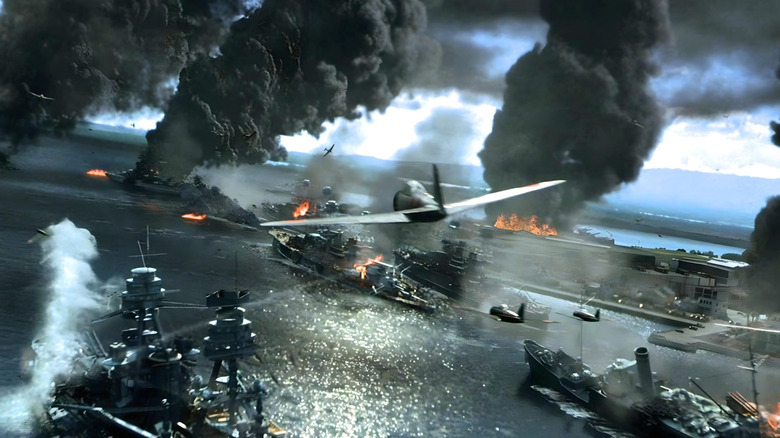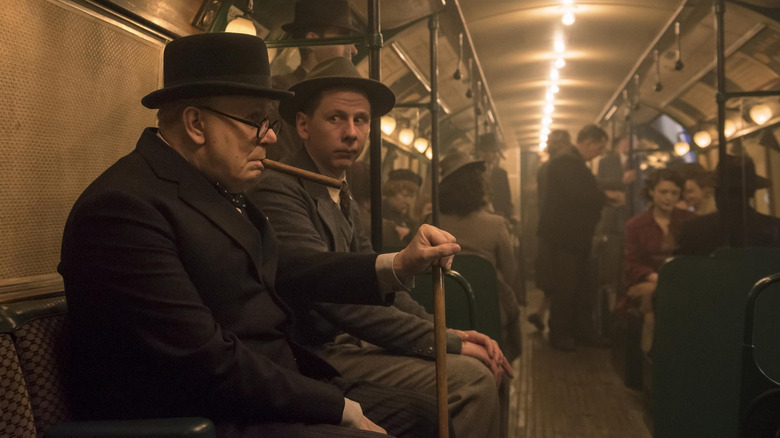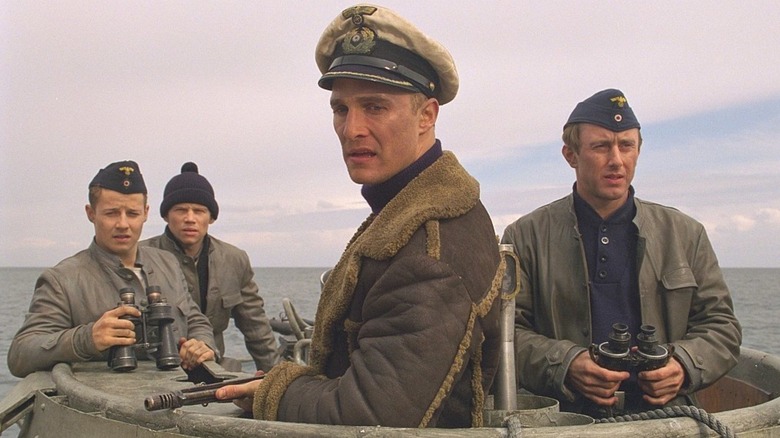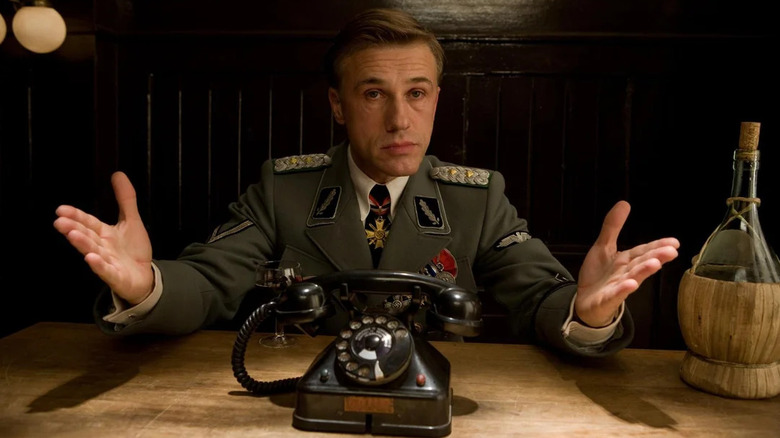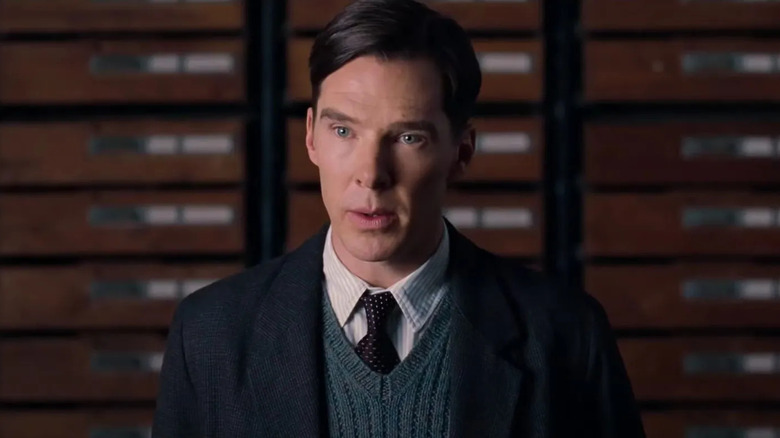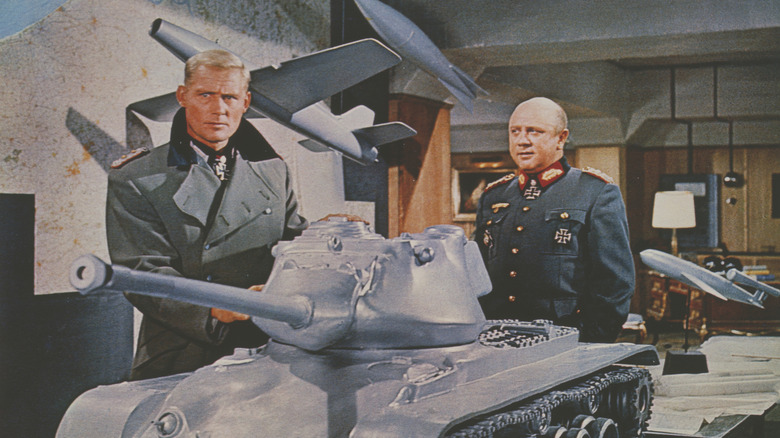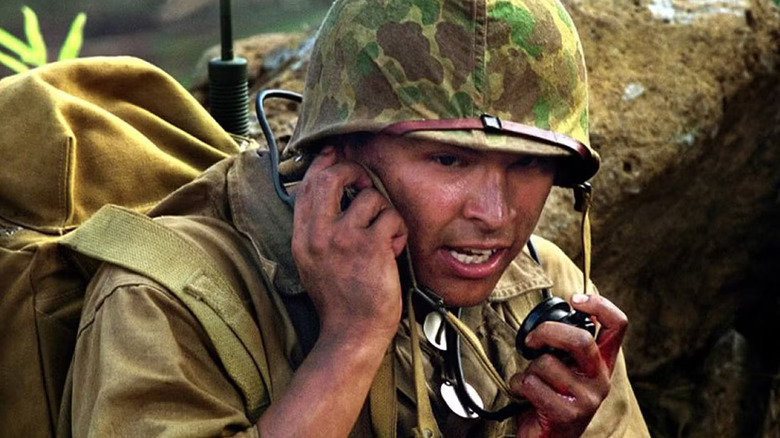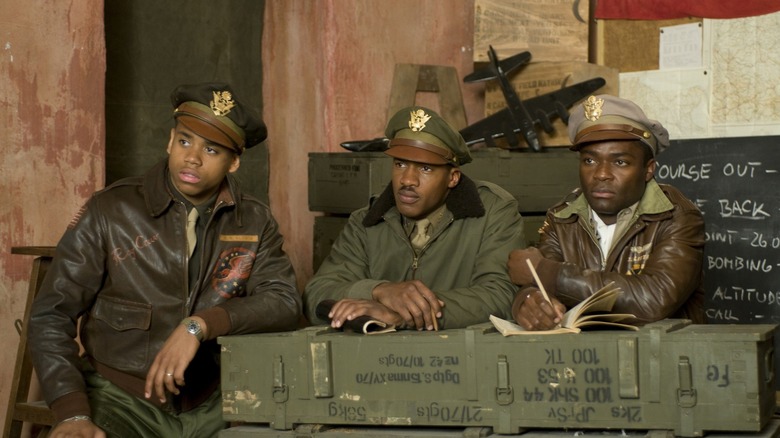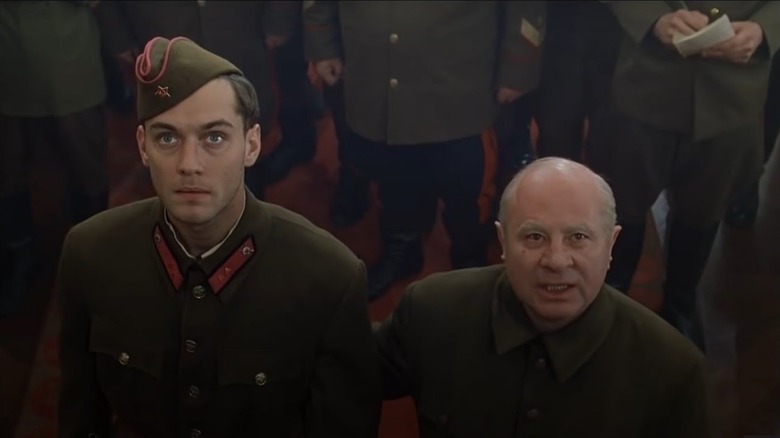WWII Movies Historians Absolutely Hate
On a certain level, it makes sense that World War II is prime fodder for filmmakers. It was a dramatic and complicated war that involved nearly every nation on the planet. From a storytelling perspective, that's a rich well from which you can draw again and again. But there's a problem of sorts: WWII really happened. That means there are people who lived through it, as well as historians who have studied the war for their entire careers. What are they going to make of a war film when they're sitting in the theater?
Perhaps it isn't fair to expect movies to be totally accurate. You can dive into firsthand accounts and official records all you want, but ultimately screenwriters, directors, actors, and many others involved in the filmmaking process have to make creative choices. Still, there are plenty of these people who strive to make reasonably accurate WWII movies that capture the reality of the war. And then, there are those who don't seem to care, beyond perhaps driving historians to distraction. For every meticulously researched war film, it seems that there is at least one that plays so fast and loose with history that you might as well be watching a fantasy. (Ahem, "Pearl Harbor," we're looking at you.) When it comes to World War II, these movies are the worst offenders as far as many historians are concerned.
Pearl Harbor
If you want to know what happened at Pearl Harbor, definitely don't take notes while watching "Pearl Harbor." The film follows the operatic exploits of two U.S. pilots played by Josh Hartnett and Ben Affleck, who enter into a love triangle with a nurse played by Kate Beckinsale. They all end up on Oahu on that fateful day, though Hartnett's character dips out of said triangle by perishing in the April 1942 Doolittle Raid on Tokyo.
But the movie was panned by both audiences and historians. The filmmakers routinely mixed up uniforms and military branches, as when Affleck's Army Air Force character is examined in a Navy hospital. Or what about when a Japanese-American character gets an odd call from someone in Japan? It's an attempt to show that Japanese Americans weren't all part of some nefarious fifth column, but cross-ocean civilian calls weren't possible at that time. And Admiral Yamamoto Isoroku's line about awakening a sleeping giant sounds cool, but it was almost certainly the invention of a scriptwriter for 1970's "Tora! Tora! Tora!"
Look closely, and you'll even see the USS Arizona Memorial in one shot, though it was built in the 1960s. Some of the technology launching Japanese planes wasn't available until the 1950s, and those planes are the wrong color. The U.S. forces, meanwhile, are flying a fighter model that didn't come out until after Pearl Harbor.
Saving Private Ryan
"Saving Private Ryan" is widely emotionally accurate and visually striking, but is it a true reflection of history? Perhaps not. Historian James Holland told Penguin Books U.K. that the visuals of the film's famous landing scene aren't right at all. First, the beach as shown in the film is too small, giving soldiers an oddly narrow bit of land to start their assault. Meanwhile, the anti-landing craft devices meant to slow down the invasion are installed backwards, with spikes incorrectly pointing out toward the sea. (They were meant to point inland, to catch and tear up vessels.) And it's worth noting a detail that will pop up in a few war films: Those machine guns couldn't fire in such long, continuous bursts. Well, technically they could, but the barrels would become so overheated after just a few hundred rounds that the gun would dramatically lose accuracy. Gunners were instead instructed to shoot in short bursts to maintain the accuracy and structural integrity of their weapon.
Historian John McManus told Insider that the film gets several things right, including the rough weather and the sense of landing on the beach under heavy fire. However, there were some accuracy flubs, including the misplaced obstacles mentioned by Holland. McManus also took issue with the way the film showed soldiers going straight up a ravine, as well as claims that Allied tanks hadn't arrived ahead of soldiers (they definitely did) and the depiction of the Germans as dunderheads waiting to get killed.
Darkest Hour
While some World War II movies are all about showing dramatic battles and acts of bravery, "Darkest Hour" instead took the tack of showing some seriously high-stakes statesmanship as Winston Churchill (played by Gary Oldman) tries to navigate skepticism of his new role as prime minister, intragovernmental bickering, the Dunkirk evacuation, and a possible Nazi invasion of Britain.
In a key scene, Churchill decides to take a ride on London's tube, surprising passengers not just with his presence, but his request for input. Should they attempt to make peace with Germany, or keep fighting? Everyone tells him they want to give Hitler what-for, and an emboldened Churchill continues on his anti-appeasement course. Only, it's not clear that the real Churchill ever took a subway. If he did (at least one account says he stumbled through the process once in the 1920s), no one remembered the remarkable spectacle of the prime minister asking regular folks for advice on international relations.
Neither would they have necessarily all answered in the same way. Not everyone was all-in to fight German invaders on the beaches and elsewhere. That's not to say they were ready to capitulate to a seemingly ravenous Hitler, either. But the situation was complicated and informed by all manner of issues, from class differences (Churchill was very definitely upper class) to wanting to avoid the bloodshed and fear many had already experienced in World War I.
U-571
"U-571" purports to tell the story of a group of intrepid American sailors who take their submarine on a mission to steal an Enigma machine from the Germans. With said machine in hand, they are able to break the Enigma code that's been evading the Allies for far too long. Beyond the very basics of the Enigma code being a thing, much that's left in "U-571" is utterly wrong. For one, the first crack into Enigma came in the 1930s, at the hands of a Polish cryptography team that included mathematician Marian Rejewski. His team's work, combined with other breaks like seized codebooks, allowed intelligence personnel at Britain's Bletchley Park to finally break open the Enigma and the coded messages used by Axis powers. Though a small number of Americans were part of the Bletchley Park team, there was no square-jawed submarine crew yanking an Enigma machine out of German hands, and certainly not one including the likes of Matthew McConaughey and Jon Bon Jovi.
In real life, there was an encounter with a German U-boat that got an Enigma machine in Allied hands, but the May 1941 incident involved the crew of a Royal Navy vessel, the HMS Bulldog. They boarded a damaged German U-boat and seized the machine, along with any papers they thought would be of use. Over here in the real world, enough people were mad after the 2000 release of "U-571" that Britain's then-Prime Minister Tony Blair condemned it in Parliament.
Inglourious Basterds
Okay, hardly anyone expects a Quentin Tarantino film to be historically accurate. But there are some details in Tarantino's World War II film, "Inglourious Basterds," that are worth a second look. The high-tension scene in which villain Hans Landa interrogates a French farmer is, to historian James Holland, comically inaccurate. As Holland told Penguin Books U.K., he argued that Landa and the Nazis under his command were "absolutely conforming to every pantomime villain Nazi" with their look — "I mean, how much leather can you fit in a squad of Germans?" he exclaimed — while the long, talky lead-up to the violence was all Tarantino.
Yet, believe it or not, there's a small kernel of truth here. For one, there's Operation Greenup, in which two Jewish emigres to Brooklyn, Frederick Mayer and Hans Wijnberg, joined the Office of Strategic Services (OSS). In February 1945, they parachuted into Austria as part of an espionage operation. Joined by Franz Weber, a sympathetic Wehrmacht officer, the trio provided valuable intel.
Another group of refugee Jewish people did similar work, as Kim Masters, the daughter of Peter Masters, told NPR. Born Peter Arany, he and his family fled from Vienna to London. Peter was arrested as an "enemy alien" but managed to join the British military as an elite commando fighting the Nazis. (This is when the name change to the more British-sounding "Masters" took place.) Both Peter Masters' and the Greenup team's stories are just as dramatic as "Inglourious Basterds" without twisting history into alternative shapes.
The Imitation Game
Given that "The Imitation Game" is meant to be a biographical film centering on the life of British scientist Alan Turing, it makes sense that the movie focuses on him. But some have questioned if the Turing you see played by Benedict Cumberbatch has anything to do with the real man. Besides quibbles about Turing's personality — was he really that rude and humorless? — there's the matter of just who cracked the Enigma code at Bletchley Park. Though Turing had a towering intellect that helped win World War II, he was part of a much bigger team.
Polish mathematicians are some of the great unsung heroes of history for first cracking the Enigma code, while the operation at Bletchley Park was hardly a one-man affair. The characters who do appear in "The Imitation Game" don't accurately reflect the collaborative nature of the effort. In fact, by 1942, Turing was hardly at Bletchley Park, as breaking the Enigma code was mostly done via machine. Turing, meanwhile, was consulting on other projects, including advising on U.S. encryption devices meant, among other things, for secret phone calls between Franklin D. Roosevelt and Winston Churchill.
It's not just Turing who's mischaracterized, either. Commander Alastair Denniston, rather than constantly butting heads with Turing, clearly wanted him on the team. And, no, it doesn't appear that Turing was at all involved with anyone communicating directly with Winston Churchill, as the scenes with the Stewart Menzies character (Mark Strong) may suggest.
Dunkirk
If you watch the Christopher Nolan-directed film "Dunkirk," you might expect that it would more or less accurately reflect the 1940 evacuation of hundreds of thousands of Allied forces from the French port of Dunkirk, nonsensical details and all. The 2017 movie has gotten plaudits for being mostly right ... mostly. Nolan did basically state that he wanted to get at the feeling of what it was like to be crowded on the beaches of Dunkirk as the blitzkrieg attacks of the Nazis crept closer, with rescue far from certain.
Only, some have noted that the scenes on the beach are far too orderly. Historian James Holland told Penguin Books U.K. that his impression of the film was that its evacuation was oddly calm and even quiet, at least in comparison to the fearful almost-chaos of the real thing. Others have likewise noted that the beaches just look too nice. Consider that it wasn't just hundreds of thousands of soldiers existing in the area, but all of their stuff, too. Only, they were more focused on evacuating people, meaning that their vehicles and other equipment had to be left behind, though disabled so that Germans could get little use out of them. Actual photos of Dunkirk post-evacuation show trashed vehicles left wherever was necessary, be that along a road or on the beach itself. By contrast, the tense, oftentimes confused scene of the same evacuation in "Atonement" is more reflective of the real event.
Battle of the Bulge
You know a movie's got to be pretty bad if Dwight D. Eisenhower comes out of retirement just to yell about it. Well, Eisenhower, the general in charge of Allied troops when the real and often under-appreciated Battle of the Bulge was fought from December 1944 to January 1945, laid down his complaints more calmly. He certainly had a right to yell, though, as 1965's "The Battle of the Bulge" really was that bad.
As World War II historian John McManus told Insider, there's one glaring oversight: Filmmakers used the wrong tanks. More specifically, they brought out tanks that had been made after the war. What's more, the tank formations seen in the film were oddly linear and not at all like how they'd been deployed in real life. Oh, and that tank-ramming sequence? Almost complete nonsense, as tank units were far more focused on using artillery than just smashing stuff with their vehicle.
Besides that, the Ardennes Forest was far more dense than what you see in the movie. It's also missing the ice and snow that plagued real soldiers at the battle. Besides the problems with tanks and terrain, the film consistently flubs facts about troop movements, uses post-war planes, shows post-war tech like C4 explosives, features strangely inaccurate uniforms, and shows embarrassingly sloppy military salutes. At least some of this could have been fixed by having a military advisor, which the film did ... only, that person was former Nazi tank commander Colonel Meinrad von Lauchert.
Windtalkers
The very basic premise of "Windtalkers" is connected to reality. During World War II, the near-constant battle to keep communications secret led U.S. forces to draw on the languages of indigenous Americans. The true history of World War II code talkers goes back to World War I, with Choctaw-speaking service members. By WWII, the effort had grown to include Diné (Navajo), Cherokee, Comanche, and many more tribespeople. Most code talkers worked in pairs in the field, with one to operate the radio and the other to transmit, receive, and relay coded messages in their native language. They were in particular danger because Japanese forces targeted radio operators in an attempt to hamper Allied communications. After the war, their work remained secret until it was declassified in the 1960s. Even then, few received real recognition until long-retired code talkers began receiving Congressional Gold Medals in the early 2000s.
So, how does the film "Windtalkers" hold up to all that real history? Not particularly well. First, there's the fact that Nicolas Cage leads a film that one might expect to instead center the stories of American Indians. Then, there's the persistent claim that some code talkers had bodyguards (true) and that those guards had orders to kill code talkers if captured. That last point is false as far as anyone can tell, though in the Marine Corps bodyguards were assigned to protect vitally important code talkers and prevent their misidentification as Japanese fighters.
Red Tails
Though it has a noble cause — allegedly telling the true story of the Tuskegee Airmen, a group of Black United States Army Air Forces pilots — the way "Red Tails" plays out isn't just historically inaccurate, but potentially offensive. Some allege that the film portrays characters as too light-hearted, making the airmen seem like jokesters in line with racist stereotypes instead of the professional service members many were. In fact, the Tuskegee Airmen, commanded by future Air Force General Benjamin O. Davis Jr., were a highly disciplined group with something to prove. As J. Byron Morris, a Tuskegee Airman himself, told a Washington Post reporter, the Black unit was set up to fail. "They wanted us to self-destruct," he said. "But B.O. Davis kept them on the straight and narrow, and the men were too self-respecting to fall apart." That means the real airmen didn't get up to many antics, though their on-screen counterparts engaged in insubordination, public intoxication, and joking around at the controls of their planes. However, this perhaps isn't a consensus view, as historian Crystal R. Sanders told Penn State University that she felt the film was overall historically accurate.
"Red Tails" also contains a number of technical inaccuracies. Its biggest involves the longstanding myth that the unit never suffered serious casualties or lost a bomber during escort missions. Yet 66 Tuskegee Airmen died while fighting (though that's one of the lowest casualty rates for units in the war) and records indicate that the group lost some 25 bombers.
Enemy at the Gates
If you're watching a World War II movie made by American filmmakers, chances are that the action focuses primarily on U.S. or British Allies. That kind of makes sense, but it leaves out dramatic points in the war. "Enemy at the Gates," which purports to show Soviet sniper Vasily Zaytsev's experiences during the 1942-1943 Battle of Stalingrad, tried to fixed this. Whether or not you find the movie compelling is up to you; just don't expect it to be accurate.
It isn't totally off-base, as early scenes where Zaytsev is hustled through a chaotic, bloody Volga River crossing and into the besieged city appear to be inspired by eyewitness accounts. Snipers were also a key part of the Soviet military apparatus, and women and men routinely served alongside one another in combat. Yet, future Soviet premier Nikita Khrushchev didn't have quite as central a role in the battle as the movie may lead you to believe, and there's an odd lack of military officers on screen. Zaytsev himself is given a strangely thin backstory, despite being, you know, the main character and a real person who not only gained recognition for accomplishments beyond Stalingrad, but lived until 1991.
There are plenty of other details to quibble over, such as issues with firearms, uniforms, and airplane accuracy. (Bombers would never have flown so low, for instance.) Then, there's the nonsensical way tanks are parked near military headquarters, basically planting a big, red "bomb us, please" sign at a strategic location.
